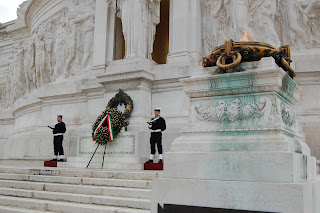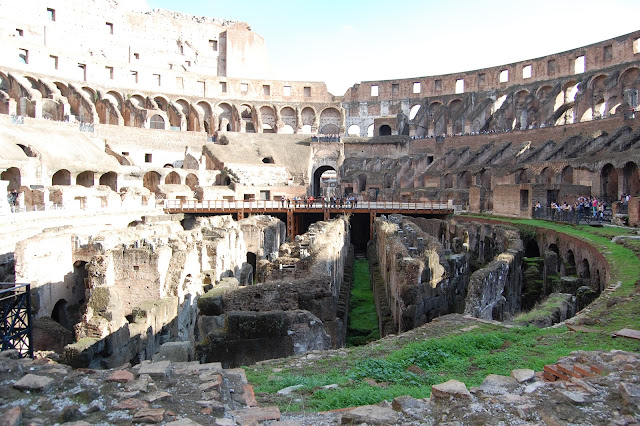 |
| What do you think is going through Abbey's mind here? Put your guesses in the comments section for my reading pleasure! |
"The Creator made Italy from designs of Michaelangelo." Mark Twain
 |
| Vittoriano (The Victor Emmanual Monument) |
The Colosseum (Colosseo) - Don't you love all the bald heads of the German tourists on our bus?
"Italy is a dream that keeps returning for the rest of your life." Anna Akhmatova
 |
| Campidoglio (Capitol Hill Square) |
"Thou Paradise of exiles, Italy!" Percy Bysshe Shelley
 |
The Church of Santa Maria in Cosmedin where the Bocca della Verita (Mouth of Truth) is located - remember Roman Holiday?
 |
| The Palatine (where the emperors lived and from which we get our word "palace." This is where Rome began. |
 |
| A Catholic Mass being held above Circus Maximus where many Christians were killed. |
 |
| There were several masses being held on that Sunday. Circus Maximus was also a private chariot race course for the emperors of Rome. |
Abbey didn't mind her first encounter with a Roman Centurion . . . . . .
. . . until he asked her dad if she was an obedient daughter and offerred to inflict a severe punishment!
"Traveling is the ruin of all happiness! There's no looking at a building after seeing Italy." Fanny Burney
Our stop at the Vittoriano (Victor Emmanuel Monument) was our first real up close look at the architecture of Rome. This monument, to Italy's first king built to celebrate the 50th anniversary of the country's unification, was gigantic, including the 43 foot statue of the king on the horse which is the biggest equestrian statue in the world. The king's moustache alone is over five feet wide, and a person could fit into the horse's hoof. So what I'm saying is that everything about it speaks of SIZE. It is over the top, and it came to be known as "the wedding cake" to the Allied troops when they invaded Italy at the end of World War II. I understand that Romans don't like the structure all that much and call it "the typewriter" or "the dentures." I think they are most upset at the placement of this inferior building on a priceless acre of ancient Rome. Soldiers guard Italy's Tomb of the Unknown Solder with the eternal flame here. |
| We investigated the Museum of the Risorgimento at the monument where they had an exhibit of artsy flags from a national contest. |
The view of Rome from this monument was the best part of the building.
There is nothing like Italian sculpture, but we were just getting started.
We walked along the Via Dei Fori Imperiali street that was closed for Sunday strollers.
I can't even name all the ruins that we saw along our stroll from the Vittorino to the Colosseum, but they included the Roman Forum, the Temple of Saturn, The House of the Vestal Virgins, and the Mamertine Prison where the apostle Peter was chained and baptized his jailers who were later martyred.
There were a lot of street performers and these are some of the most interesting. Many of them played hauntingly beautiful music, but some of them were just downright terrible and out of place, like the quasi Native American Indians with their drums and feather headdresses who weren't worthy of a photo.
Near the Colosseum is the Arch of Constantine built in 312 to celebrate Constantine's victory over Maxentius in the battle of the Milvian Bridge - you know that one battle which was one of the great turning points in history and allowed Christianity to become legalized. :) Constantine was no dummy and had the arch covered with exquisite recycled carvings of high Roman art that glorified previous emperors - Hadrian, Marcus Aurelilus, Trajan, and Augustus. Constantine hung on to the glorious Roman past and took his place with the big dogs.
Wasn't the sky gorgeous?!
The Colosseum is 2,000 years old and looks it! This is the embodiment of the magnificence of Roman engineering in how they pioneered the use of concrete and the rounded arch. Its real name is the Flavian Amphitheater. Nero's gigantic long ago destroyed statue called the Colossus was adjacent to the ampitheater and it is where the Colosseum name came from. This is where the gladiators did their thing. This was where the Romans got their kicks watching animals hunt each other and then criminals and gladiators hunting the victorious animals and humans. They would even have mock sea fights called naumachiae where they flooded the arena with water. I guess this was the ancient version of Survivor, complete with animal lifting elevators that would rise from the subterranean holding cells to surprise the entranced audiences and elaborate sets designed by professionals. There was even an enormous canvas awning that could be hoisted over the spectators' heads for shade - it just required a full-time army of sailors on site to pull it into place. Listening to our guide tell of the brutal cruelty that was witnessed by 50,000 bloodthirsty people at a time made me think of The Hunger Games series of books I read recently.
Our guide was well-informed and entertaining as she used her delicate, very expressive Italian hands to describe the building and horrors of the arena. She said it is a myth that Christians were killed in the Colosseum, but they were killed in the Circus Maximus.
You can see the subterranean maze here that would have been underneath the arena floor during the Colosseum's heyday. It is amazing to think of the "modern" technology they had with the elevators. Instead of machine powered though, they were slaved powered.
The cross marks the area where the emperor would sit and watch the games as they unfolded. There were over 100 festival days each year during the Flavian Empire which were national holidays of celebration and entertainment. Our guide told us that there was a very intricate system in place to protect the audience from the wild animals and cutthroat antics in the ring - archers were positioned every few feet at the perimeter to kill anything that crossed the line and threatened the crowd. They say they are still uncovering ruins with animal skeletons from the killing that took place. Yuck!
Vogue . . vogue . . . vogue . . . vogue
Abbey is a pretty good photographer, don't you think?
Eating in Italy was always a pleasure, but I made the mistake of ordering this. My idea of prawns has nothing to do with eyeballs staring at me, so Brett was delighted to help out and Abbey was kind enough to share her pizza. Italy is the place for kids to eat. Pizza, pasta, mac and cheese, and gelato every day!
The sun was starting to set so we decided to hop on the green bus and end our touring where it began. We headed back to the hotel and enjoyed a very chilly ride through the sparkling city. I think Abbey was feeling blessed that she didn't have more energetic parents at this point. She was well on her way to sleep and, even though she is ten, she let her dad hold her on his lap because he is a human heater.

































































